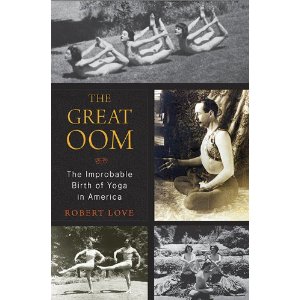
First line: Pierre Arnold Bernard, the first American yogi and a spiritual hero to members of the Lost Generation, was conducting a tour of his property for Joseph Mitchell of the New York World Telegram.
From the inside cover: From the gaslit parlors of the Gilded Age to the opulent excess of the Roaring Twenties, hatha yoga couldn’t have followed a more bizarre and sinuous path than it did in the hands of a young Iowan born as Perry Baker. Re-creating himself as Dr. Pierre Bernard, he rescued a discipline banned in Victorian India, packaged it for Americans, and taught legions of followers the yoga we know and practice today.
Reviving a forgotten tale of mysticism, intrigue, and the American dream, The Great Oom traces the practice of yoga from Bernard’s moonlit “Tantrik” rituals in the 1890s San Francisco to its arrival in New York City, where his teachings were adopted by the Wall Street barons and Gilded Age heiresses who would bankroll his luxurious Jazz Age ashram on the Hudson River – the first in the nation. With celebrities like Leopold Stokowski hitting the mat with Vanderbilts, Goodriches, and Great War spies, Bernard’s brand of yoga (which initiates signed their names in blood to learn) was reviled as much as it was revered. He survived decades of ruthless attacks by the press, which branded him the Great Oom, Loving Guru of the Tantriks. He outran the police, who raided his yoga schools on both coasts, and outlasted the clergy, who condemned his yoga colony as a godless love cult. Still, Bernard’s hatha yoga thrived on the changing tides of a nation constantly reinventing its pursuit of well-being. Through the Third Great Awakening movements of Theosophy and spiritualism, the health fads of John “Corn Flakes” Kellogg and Bernarr MacFadden, and the self-help psychology of Emile Coue, Bernard tapped into the metaphysical zeitgeist – not to mention many a well-heeled lady’s heart – to keep seekers coming to him to learn the cobra pose. By the time the yoga boom arrived here in the sixties, his proteges had been teaching the asanas to their own followers for decades.
The Great Oom is nothing less than a human sage of mysticism, pop culture, wealth, and celebrity giving rise to one of America’s most popular pursuits. It is the inspiring life story of the unlikeliest of gurus, a classic tale of creation and enterprise, and a stunning cultural history of yoga in the West.
My thoughts: I read this book because it was this month’s selection for my book club. If it weren’t for that, I’m not sure I would have finished the book. While there were parts that were interesting, I found it to drag on at times. It seemed as if it were a bunch of small vignettes put together to create a book. Yes, the life of Bernard was interesting – he certainly seemed to have his hand in a little bit of everything, from a baseball team to circuses and performing elephants to elaborate parties that went on all night. My book club picked this particular book for two reasons – we all take/have expressed interest in yoga and we happen to live near Nyack, the place where Bernard set up his mega-colony. It would have been helpful if there were a map included in the book – even though I live 10 minutes away, I still don’t know the town that well and because Bernard was in Nyack 50 some-odd years ago, things aren’t as they are now. I also would have loved to see more pictures of the area…yes, there was a picture at the beginning of each chapter, but I really wish there were some pictures of the elaborate costumes that Bernard and his wife would pick out for their guests (yes, Bernard decided what costume everyone would wear!). I also would love to have seen an overview shot of the Clarkstown Country Club property. While I didn’t love the book, I did find it interesting and it left me wanting to know more about Bernard’s impact on Nyack – perhaps I’ll have to do a little digging into this myself!
(I borrowed this book from the library.)
Well, I have to admit, the subject matter of this one definitely sounds really interesting. But i can see that it might end up dragging in parts.